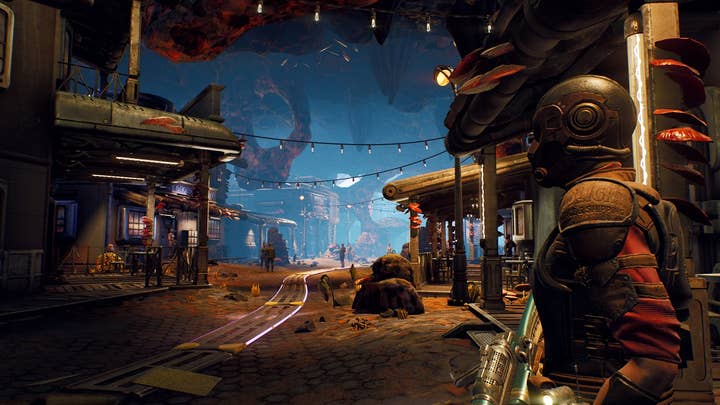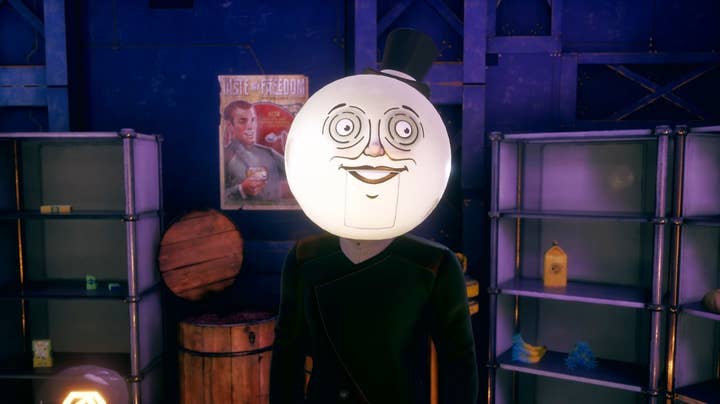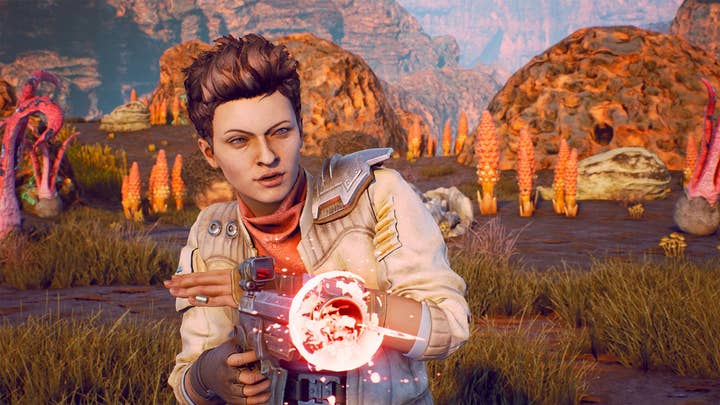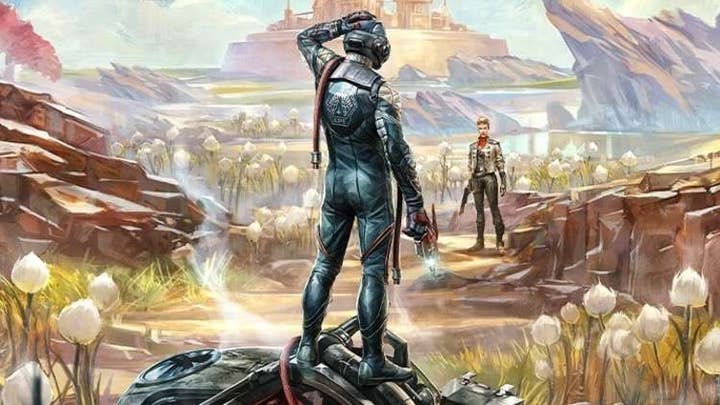The astronomical challenge of recording The Outer Worlds
How did Obsidian handle voice work for a game with almost 350 characters, 40 voice actors, and recording studios in different countries?
The work that goes into building a grand scale, AAA-caliber RPG like Obsidian Entertainment's The Outer Worlds is enormous. Thousands of production variables must be woven together in a way that adheres to some semblance of logic and credibility. That's true enough for the entire game, but even a single aspect of it -- like the voiceover work, for example -- is a daunting task of incredible complexity.
Justin Bell is the in-house audio director at Obsidian Entertainment, which means he's one of the people that critics and fans can thank for the voice acting in The Outer Worlds.
"There are 346 distinct characters in The Outer Worlds," says Bell. "This was a fulltime undertaking, to say the least."
And not just for him. Bell says that there were five producers on staff at Obsidian who contributed to The Outer Worlds' voiceover recording. "[Those producers were there] to ensure that everything was going smoothly, that everything was being communicated in a timely and accurate way," he says.
Before a single line could be recorded, Bell needed to have a sophisticated infrastructure in place, and he credits producer Matt Singh for much of that. Singh coordinated casting, scripts, and recording sessions across the sites where voiceover work was taped.
"We recognized early on that it would be impossible for us to cast as many actors as we had characters," Bell adds.
For the 346 main characters in The Outer Worlds, Obsidian hired 40 actors in total
For the 346 main characters in The Outer Worlds, Obsidian hired 40 actors in total. Bell says the team tried to keep the cast as small as possible to ensure consistent quality of performances throughout the game. But doing so created other challenges.
"We gathered character traits for all characters, like age, gender, ethnicity, archetype, world location, quest location, and we did some analysis to determine how we could cluster them together into groups that would be assigned to a single actor," Bell explains. "After that, it became a balancing act of ensuring we had enough actor variety per group so that we didn't hear the same actor over and over again, which would be immersion-breaking for the player."
Never underestimate the power of a spreadsheet
During development, Bell and his team cooked up a concept called Character Groupings. "Rather than cast for individual characters, we would cast for their suitability for one of these groupings," he says. On the highest level, The Outer Worlds' characters were divided into two general categories: Townies and Guards. Guards had complex combat AI routines, while Townies had simpler AI routines.
"From a narrative perspective, each corporation in the Halcyon Colony employs their own paramilitary 'police force' to ensure corporate policies are enforced and protected," he adds. "So we called all of them Guards. Every other civilian in this world is what we call a Townie -- these are people who are simply living their lives, trying to make do. Though some are obviously 'making do' better than others [are]."

Bell says that the audio team also recognized a subgroup that they called Factions.
"The Factions in The Outer Worlds are groups of characters that are aligned with one another," he explains. "They're either at odds with, or in collaboration with, other Factions. That's how we represent the internal politics of our game. And so, within the Guard grouping we had a subgrouping for the various Factions."
Sorting characters by Type, especially when you have hundreds of characters, made this impossible undertaking manageable, Bell says.
"To give you a picture of what that looked like, I had a really big spreadsheet with every single [character] attribute on it. That included Gender, Faction, Ethnicity, and every Location in the game. I looked for commonalities to figure out where the so-called 'hot spots' were, to determine how many of a given type of actor we needed."
He adds: "If we tried to go bespoke across the board? That would have been untenable. The amount of effort that would require... I don't know. It's probably possible, but it's just unrealistic."
"If we tried to go bespoke across the board? That would have been untenable"
Justin Bell
It took seven narrative designers, three area designers (who were tasked primarily with ensuring that casting assignments didn't lead to actors talking to themselves in the game), and three audio producers to pull this off.
"Then there was also 'script prep' and additional casting support from the writers and area designers," Bell adds, "of which there were about ten altogether. So, in all, there was a ton of prep...to get ready for recording. It involved many people."
For help, Bell and Obsidian leaned on Game On in Montreal, a boutique production house specializing in motion capture and audio recording. Game On managed the voice-recording workload, mitigating some of that work. "We'd send scripts to Game On in Montreal," Bell says. "Then Game On would send back auditions for us for review, and they'd schedule actors and directors for recording sessions."
Embrace the cheese
One of the people who directed the Montreal-based voice actors at Game On is Simon Peacock, a voice actor and voice director based in Montreal. He's originally from New Zealand, and still wields a fairly pronounced accent. Peacock directed a large swath of the voice acting in The Outer Worlds at Game On, most prominently for the Ellie Fenhill character, played by actor Victoria Sanchez, and Felix Millstone, played by Jonathan Maxwell Silver.
Peacock either takes the Metro in Montreal, or rides his bike to the studio. As a director, he likes likes to make sure that he arrives before the talent does. He does voice work as well, and says he doesn't like it when he's there first and the director "just breezes in five minutes before we start."
"I'm old school that way," he says, "and I think that me being there first helps set the tone... For Outer Worlds, my mornings also meant making sure our [internet] connection to Obsidian was working properly, and that we had the correct writers lined up for each character."

Obsidian is known for its narrative emphasis and deep, complicated characters, and Peacock says The Outer Worlds script was no different. The intelligence of the work was obvious to Peacock, while he says the script had a unique sense of self-awareness about it that felt refreshing.
"Games simply haven't quite evolved to that level yet, which is something you see most commonly in film and TV," he says. "There's humor in [The Outer Worlds] which, to me, is so essential to the human condition. In the darkest moments, that's usually when people turn to humor. Yet in games, when we're playing in these incredibly dark situations, where developers become obsessed with creating that environment and feeling, often there's nothing there to try and break that darkness."
"If it's not entertaining for us while we're recording it, then it's unlikely to be entertaining for everybody else"
Simon Peacock
Peacock says that bringing in writers from outside of games certainly helps facilitate this.
"I think it's going to be interesting in the next few years to see how much of that gets incorporated into games," he says. "Like I said, it's harder to do humor in a game."
Not only does The Outer Worlds boldly attempt humor, Peacock says, but it also attempts a particular type of humor: "It's not just jokes for the sake of jokes. The jokes all have a point, and the game is very much a satire. Which is, quite possibly, an even harder form of humor to nail in games."
Peacock has a simple benchmark for comedy that he tries to adhere to when recording voice work for a game.
"If it's not entertaining for us while we're recording it, then it's unlikely to be entertaining for everybody else. The humor has to resonate the first time it's read. Right there in the recording booth."
Peacock also agrees that the actors hired to do the voice work have to be diverse, even eccentric.
"One of the most important things in casting is finding a group of people who all come from different perspectives," he says. "So it doesn't become just one homogeneous voice throughout the game. I think that's something we did a good job of [in The Outer Worlds]. We had a lot of really good actors. Actors with a sense of humor almost always do a better job, because we are making them do ridiculous things. And actors who take those things too seriously, who don't have that sense of humor, often struggle to get to the energy level we need for video game performance."
As a voice director who has worked on many games in Montreal and around the world, Peacock has a phrase that he reliably uses in studio: Embrace the cheese.
"I wanted there to be a sweetness, and also a bit of an anxiousness in her. Because she is this very endearing, sweet person"
Ashly Burch, on her character Parvati
"Because it really is part of video games," he adds. "There are some lines in [the script] which, when you read them on a page, they look incredibly cheesy -- just, no one could ever actually say this. But if the actor has that sense of fun about it, and commits entirely to it... then it will work in the context of the game. What you want are actors that have an understanding of games... or actors with enough trust in their director and their writers to just embrace it and go for it."
Characters With character
Veteran actor Ashly Burch plays Parvati Holcomb. Parvati is a smart, savvy character who serves as a skilled engineer.
"When I auditioned for the game, I wasn't familiar with the larger game at all," Burch says. "I had what are called 'sides,' which are vertical slices of scenes. Sides give you a little backstory, some lines, a character arc -- that's it.
"You could tell that it was a very harsh world, but that [Parvati] was not affected by that [harshness] in the way that you imagine other people would be. Parvati insulated herself, or maintained a sort of moral center, or a sense of hope that other characters had allowed to erode in themselves."
Pavarti is tough, sure, but Burch saw a sweetness in her, too. "I really wanted there to be a sweetness, and also a bit of an anxiousness in her," she says. "Because she is this very endearing, sweet person."

Burch has extensive experience doing voice work for indie and AAA games, and by this point feels that she can usually infer how good the game will be from the quality of the writing on her first sides.
"When they described the plot for me, I could see this was a compelling landscape. Then, as you get into it, and you listen to the conversations that other characters are having, you become more involved in the lore and the world building through these lines of dialogue."
Burch says that The Outer Worlds script also revealed something raw and real about the characters.
"Parvati's story is so personal and so intimate," she says. "That's a really rare thing for games. You're used to large stakes, where life and death are on the line. That's not to say that isn't present in The Outer Worlds -- because it is -- but Parvati's main quest line is getting her confidence up enough to ask someone out on a date, then taking that person out on that date... So it's very personal, and it's very intimate."
"I've been on titles where the writing was great, character development was great, the story is there, but the gameplay is not"
Amanda Wyatt
But Burch says that Pavarti is a fan favorite for other reasons, too. "People respond to Parvati so much because of her representation, too," she adds. "I don't think I've ever seen this kind of representation in anything before. Because Parvati is a biromantic asexual, and it's such a unique story. Also, just look at the way that people responded to [Parvati]. Her story is one that I think people desperately needed to have represented."
As for the cross-continental nature of the production with recording in Los Angeles and Montreal, Burch wasn't bothered by it.
"Games are increasingly international productions. I think it's good to have that international influence. It's good to have more diverse groups of people from different places. I think that can only add more depth to the game that you're creating. The game world in The Outer Worlds is already rich and intriguing, and the fact that it is being brought to life by people from so many different places? I think that creates the sense that this is a very different world that you're stepping into."
Be informed
Amanda Wyatt is in a car driving down the freeway in the middle of the night, on her way from the airport back to her Los Angeles home. She's worn out from the day, but happy to talk about her involvement in The Outer Worlds. Wyatt is Peacock's counterpart in Los Angeles. She handles casting and directing duties at the Los Angeles-based voiceover studio Talkback, working with Burch and handling sessions for most of the game's companion characters.
Like Burch, Wyatt knew right from the start that the project was special because of the writing. Strong writing, Wyatt says, has its advantages, and she was "literally praying" that the gameplay for The Outer Worlds was as strong as the writing.

"Because I've been on titles where the writing was great, character development was great, the story is there, but the gameplay is not," she says. "So, unfortunately, it doesn't do well. But Obsidian just had the trifecta with this. Which is awesome."
The big difference, Wyatt says, is how invested the writers were in development. Every companion character in the game had his or her own personal writer.
"That writer got to know [the character] in a way that was so informed. The writer literally lived with the character for a long while. Any question that we had... they had an answer. Always."
Wyatt calls The Outer Worlds a well-informed production, "and all that information from Obsidian, through the writers, trickled down to me and to the actor." This kind of infrastructure, Wyatt says, is an exception.
"I can't tell you how many games I've done where sometimes the writer is not even involved in the project anymore [by the time we get to the recording of the voiceover]," Wyatt says. "So we don't get those answers to questions like, 'Well, why would she say that in this situation?'"
"[A]ny question that we had like, 'Well, what would [this character's] motivation be here?' They had an answer. Always"
Amanda Wyatt on working with Obsidian's writers
Wyatt says that the biggest challenge for her was knowing what the player is responding to.
"Branching dialogue gives players a choice. You need to record dialogue to accommodate all responses. It's incredibly complicated. But, again, I give props to Obsidian for formatting and constructing the script in such a way that kept us informed during V.O."
Wyatt describes voiceover production on The Outer Worlds as "buttoned up," with everything on the production side kept as tight and efficient as possible.
"Having everything organized like that allowed the actors to stay immersed in the characters," she says. "The actor could come in, and they were able to live and breathe in that character for the four hours that we recorded. That's pretty infrequent that that happens."
Wyatt admits that she was "really nervous" about the complexity of The Outer Worlds' audio process, but says it all came together in an elegant way despite her concerns.
"Especially since we were doing bicoastal recording, I didn't even have time to get to know what the other characters were doing. I know they recorded the Ellie character in Montreal. Again, Obsidian was always present, on all of the recording sessions. Either there was someone on Skype in Montreal, or someone on Skype in LA, with us, ensuring that that continuity was there."
Wyatt admits that it's not always easy to have faith in other people, and had high praise for her collaborators at Obsidian and Game On.
"We had to trust," she says. "We had to stay in our lane. We had to know that whatever was being done [3,000 miles away] in Montreal was going to be as good if not better than what was being done in LA. Again, I give Obsidian credit for trusting that could happen in both locations simultaneously."

The Outer Worlds is a big, brassy gaming experience. The production broke new ground in programming, writing, and voiceover, and it wound up a critical and commercial success.
Production was complicated, to say the least. An independently developed game? -- Microsoft only acquired the studio in the last year of production -- With hundreds of characters? It seemed like a recipe for disaster. Making matters worse, production literally stretched across North America, from Los Angeles to Montreal.
Part of the inherent joy of playing The Outer Worlds is the optimism that feels sewn into the very fabric of the experience. It's generated by those long-distance production teams, working in tandem, doing right by one another -- and being amazed by one another.
Long odds aren't always a bad thing for a production team. Sometimes, a bit of absurdity and surreality helps. Despite geographical distance and overwhelming complexity, Obsidian got it done, in a very big way.
For the record: This article originally stated there were seven full-time audio producers on The Outer Worlds. After publication, an Obsidian representative reached out to clarify that the project had seven audio designers (most of whom didn't work on voiceover) and five producers who worked on voiceover at various times throughout development, noting Matt Singh was the person overseeing day-to-day recording production.

